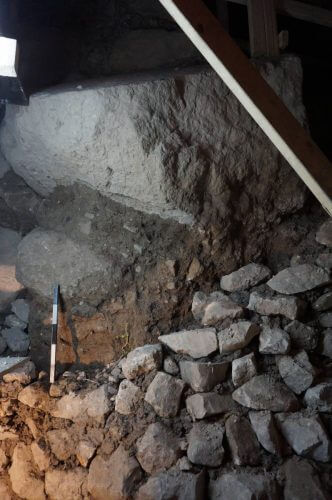Scientists from the Weizmann Institute re-dated the construction date of the great fortification tower at the Gihon Spring in Jerusalem with the help of remains of coal, seeds and bones

The Gihon Spring, located in the foothills of the Old City of Jerusalem, was once a central site for the city's residents. One of the evidences of this was discovered more than a decade ago, when archaeologists uncovered the remains of a huge fortification tower built to protect this essential water source. Based on pottery and other local findings, the archaeologists dated the tower to 1,700 BC - the Middle Bronze Age. however New research of the scientists of the Weizmann Institute of Science provides evidence that the foundation stones of the tower were laid only in the Iron Age - 1,000 years later. These new findings highlight, among other things, how advanced dating methods can contribute to understanding the history of the region.
Why is it even necessary to re-date the age of the fortifications with scientific tools? Since 2012, excavations have resumed in the area of the Gihon Spring led by Dr. Joe Uziel and Nachshon Zanton from the Antiquities Authority. The two discovered that the base of the tower was not built on a mother rock and therefore turned to Dr. Elisabetta Boerto - Head D-REAMS Laboratory For dating using the carbon-14 and head method Max Planck-Weizmann Center for Archeology and Integrative Anthropology - As part of the ongoing cooperation between the Weizmann Institute and the Antiquities Authority. Dr. Buarto explains how she and her post-doctoral researcher, Dr. Yohanna Regev, approached the task: "As scientists, the huge blocks of stone at the base of the tower cannot provide us with any information about the date of construction other than the fact that whoever placed them must have had the ability to move such heavy stones. However, under the stones, it is possible to identify archaeological layers that can shed light on the date of the last settlement of this place before the construction of the tower."
The unique archaeological approach of Dr. Boarto's laboratory team begins with the planning and execution of the samples in the field and the excavations - jointly with the archaeologists working at the excavation site. "Getting your hands dirty is part of building reliable dating," explains Dr. Buarto. During the field work with the archaeologists, and then in her laboratory, Dr. Boarto and Dr. Regev identified some very distinct layers. From these layers, the researchers carefully collected remains of charcoal, seeds and bones - organic materials that can be dated using the carbon-14 method.
The first sample was composed of sediments taken from low to medium altitude layers, and accordingly the dating coincided with the archaeologists' original hypothesis. "But between the large foundation stones and the materials we sampled initially there were another half a meter of sediments," says Dr. Buarto. The presence of separate and continuous layers identified using microarchaeological tools and carbon-14 dating allowed the researchers to also date the layers closest to the tower.
The scientific dating of the construction of this massive tower will have implications for future attempts to date construction and settlement in ancient Jerusalem."
The carbon-14 method is based on measuring the concentration of radioactive carbon 14C in an archaeological specimen. These carbon atoms are found in every living thing in a very small but stable ratio to that of normal carbon. However, unlike regular carbon atoms, these atoms decay at a known rate, so their concentration decreases after the death of the organism. At the Weizmann Institute, the measurement of the concentration of the radioactive carbon atoms is carried out with the help of an accelerator, so that the results obtained are extremely accurate even when it comes to tiny samples, for example spermatozoa weighing a few milligrams.
The date obtained using this method is 800-900 BC - that is, about 1,000 years later than the archaeologists estimated. This dating associates the tower with a completely different historical period - the Iron Age as opposed to the Middle Bronze Age.
In order to leave no stone unturned, Dr. Boarto and her team tried to come up with plausible explanations for the result not being representative of the original construction date, for example renovations that were carried out at a later date. However, the researchers believe that the fact that the foundation stones rest on layers of soil containing the remains of everyday life is conclusive evidence that the later date is correct. Dr. Buarto concludes: "The scientific dating of the construction of this massive tower will have implications for future attempts to date construction and settlement in ancient Jerusalem."

5 תגובות
It fits D. According to Kalstein, there was no significant settlement in Jerusalem before that.
To my father: check the dirt on which the stones are placed...
How can one be sure that measurements in the layers next to the tower are from the date of its construction?
Perhaps many years after the construction of the tower the area next to it was kept clean and only a thousand years after that layers of organic material began to accumulate there?
Osa was king of Judah from 908 BC to 867 BC.
Chronicles XNUMX, XNUMX, XNUMX-XNUMX:
"And build fortress cities in Judah. Because the land is quiet and there is no war with it in these years because God has allowed it. And he said to Judah, "We will build these cities and build a wall and raise doors and bolts..."